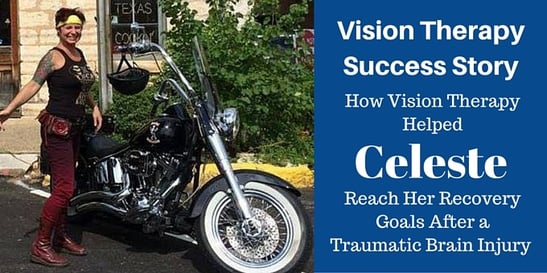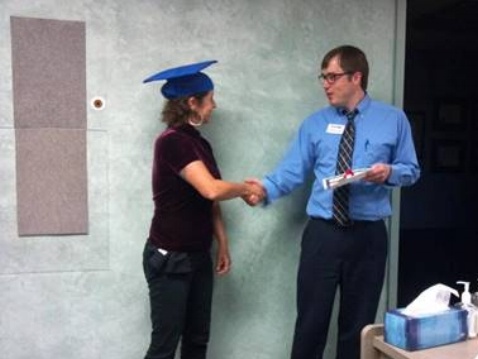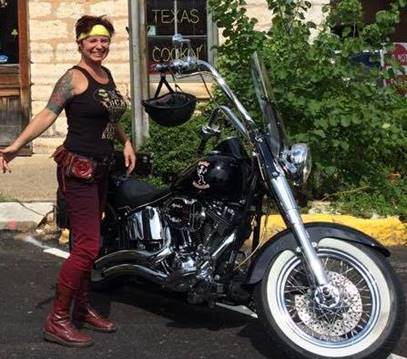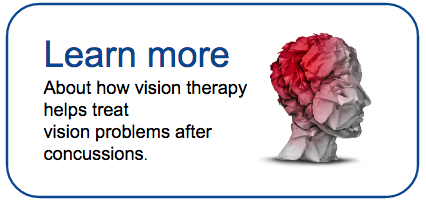
After a nearly fatal motorcycle injury and subsequent brain surgeries, Celeste Glover’s visual system was dramatically affected. Her recovery through vision therapy serves as an example of how the brain, eyes and visual pathways all work together.
Celeste was an active athlete, competitive roller derby skater, and a motorcycle enthusiast. One day, in the middle of a 2K mile motorcycle ride, she was travelling through Texas and disaster struck.
Going 80 mph, she lost consciousness and fell headfirst onto the pavement. The impact was so powerful that the back of her skull was crushed.
Celeste was airlifted to a hospital where she underwent brain surgery. Part of her skull was cryogenically frozen, and she convalesced in a hospital before returning home for three months of physical therapy.
In this audio interview, as well as a written account below, Celeste tells her story. At the end of this post, Dr. Brandon Begotka recalls the vision therapy treatment that led to Celeste’s amazing recovery.
Celeste’s Story
Hi, my name is Celeste. Five years ago, at the age of 37, I began vision therapy at The Vision Therapy Center. I had suffered a traumatic brain injury four months prior and gone through craniectomy and cranioplasty surgeries.
The resulting nerve and tissue damage had crossed my eyes and dramatically reduced my brain’s ability to understand vision. I had a long way to go, but I knew where I was headed. The people at The Vision Therapy Center guided me to a place where I was able to reach my recovery goals.
From the very beginning, I could see that their methods would work for me. At our first meeting, we talked about the link between our brains and our instincts. How after an injury like mine it is not uncommon for the brain to “forget” something it already knows.
 Celeste graduating from vision therapy.
Celeste graduating from vision therapy.
In my case, how to process light into vision. We all know about muscle memory. The brain muscle has it too. The Vision Therapy Center’s philosophy is that with the use and practice of a variety of different exercises, this memory will return and again become instinctive.
As a personal trainer and athlete my whole life this made total sense to me. I was all in. I set the goal of being able to comfortably ride my motorcycle again in one year’s time. Practicing my exercises became something I looked forward to doing every day. They were creative, challenging and fun. They incorporated using my whole body inside and out.
Often, I would go into the garage and practice while sitting on my repaired motorcycle. I would tell it, “it’s ok honey, you didn’t drop me, I dropped you.” Then dream of long trips on open roads while I massaged my brain with my eyes.
That’s what practicing these exercises feels like, massaging your brain. The rolling, stretching and focusing movements create a massage-like feeling on that brain muscle. It is very comforting.
After nearly eleven months of weekly visits and daily practice, one day I graduated. Comparing the results of my standardized tests showed incredible results! I actually tested at 20/20 vision in each eye! My peripheral vision, depth perception and focus reflexes were almost completely back to normal.
By this time, I had been driving a car again for six months. I had even tooled around the neighborhood on my motorcycle some. On graduation day, I rode. 68 miles, nose to the wind.
Today Facebook reminded me that four years have passed since shaking hands with Dr. Begotka and receiving my diploma. My injury was intense. I am still healing from some of its effects and will be for some time to come. I still struggle with keeping both my eyes pointed in the same direction all the time.
 Celeste with her motorcycle.
Celeste with her motorcycle.
Somehow, this minor inconvenience is of little consequence considering the excellent quality of vision I now experience through these silly eyes. My improvement continues to reach further and further landmarks. Most people don’t even notice anymore when talking to me.
Not a day goes by that I don’t still practice the techniques I learned at The Vision Therapy Center, which is why my healing continues to make progress. With the added benefit that it just feels so good.
Thank you, TVTC, for giving me the tools to heal myself while bringing my brain and eye muscles so much physical pleasure.
Celeste’s Functional Vision Problem - A Clinical Overview
In this section, we share clinical data for fellow optometrists and medical practitioners.
Initial Diagnoses:
Constant Alternating Esotropia
Ocular Motor Dysfunction
Left Superior Oblique Palsy
Left Cranial Nerve VI Palsy
Accommodative Insufficiency
Initial Reason For Visit: Constant diplopia at distance and near, fluctuating blur at distance and near throughout the day, worst in AM.
Goals: Be able to read and drive again.
Visual Acuity
|
Pre-VT Unaided Acuity |
Far |
Near |
|
OD |
20/25 |
20/20 |
|
OS |
20/50 |
20/20 |
|
Post-VT Unaided Acuity |
Far |
Near |
|
OD |
20/25 |
20/20 |
|
OS |
20/25 |
20/20 |
|
Pre-VT Cover Test |
Far |
Near |
|
35 PD CAET, 5 PD L HyperT |
30 PD CAET, 5 PD L HyperT |
|
Pre-VT Cover Test |
Far |
Near |
|
30 PD CAET, 5 PD L HyperT |
35 PD CAET, 5 PD L HyperT |
NSUCO Assessment of Pursuits and Saccades (Scale of 1-5)
|
Pre-Vision Therapy |
Pursuits |
Saccades |
|
Ability |
3 |
4 |
|
Accuracy |
2 |
3 |
|
Head Movement |
3 |
3 |
|
Body Movement |
3 |
4 |
|
Post-Vision Therapy |
Pursuits |
Saccades |
|
Ability |
5 |
5 |
|
Accuracy |
4 |
4 |
|
Head Movement |
4 |
4 |
|
Body Movement |
5 |
5 |
Accommodative Amplitudes
|
Pre-Vision Therapy |
|
|
OD |
2.00 D |
|
OS |
2.00 D |
|
Post-Vision Therapy |
|
|
OD |
6.00 D |
|
OS |
6.00 D |
Post-VT History: Diplopia only noted when ‘scanning.’ Improved cosmesis, clear vision at distance and near. Able to read and operate vehicle and motorcycle comfortably.
Discussion: This is an excellent example of neuro-optometric rehabilitation following a traumatic brain injury to achieve a functional cure in a case of strabismus. Although the patient retained the same amount of esotropia pre- and post-vision therapy, her initial reasons for visit were addressed and goals for vision therapy were met.


